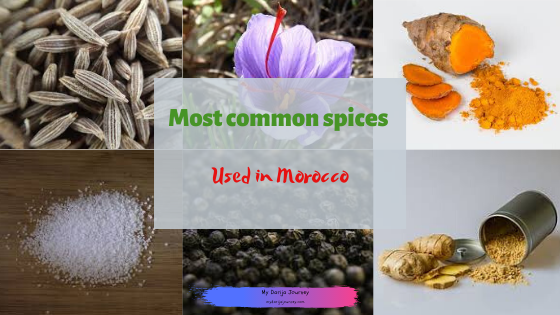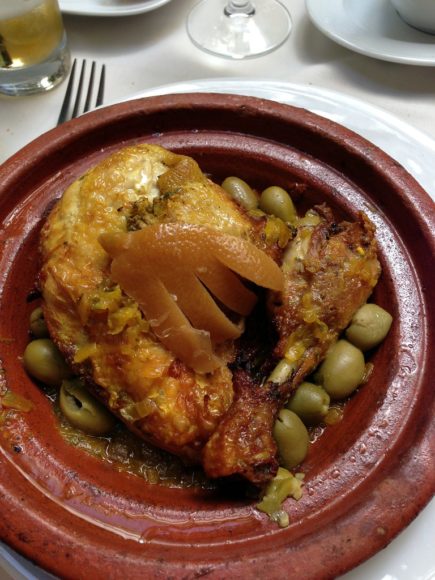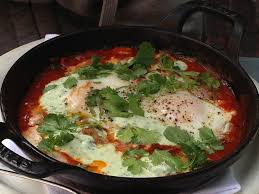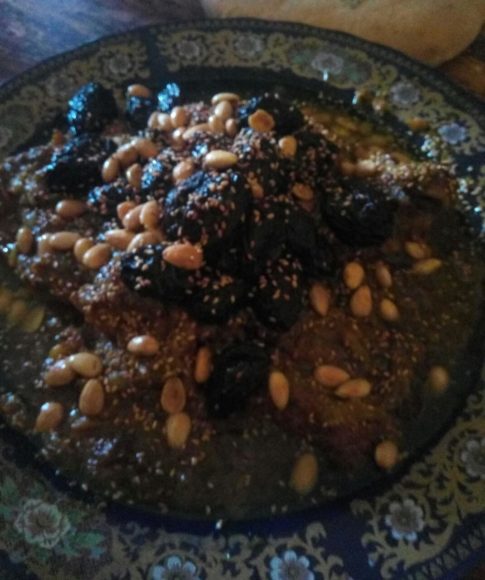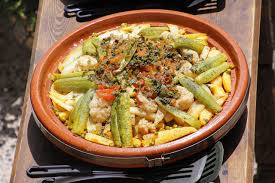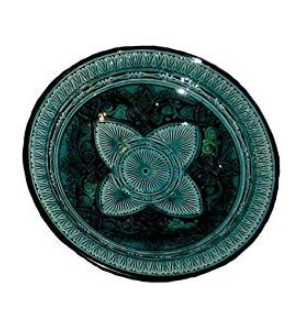The other day, I was speaking with my wife about Moroccan food. I told her, I love Moroccan food and I wished that I could cook Moroccan food just like her. She said it’s very easy, there are some core Moroccan spices used in almost every dish. I didn’t believe her at all. Moroccan cuisine has so many different dishes, all of them delicious so I couldn’t believe that they all use the same core Moroccan spices. She then went on to tell me the spices commonly used.
Here are the most common Moroccan spices used in Moroccan dishes.
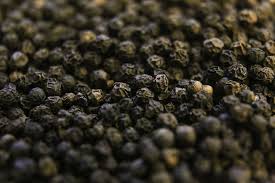
Black Pepper – Cultivated for its fruit, known as a peppercorn, which is usually dried and used as a spice and seasoning. Peppercorns are then dried and crushed into a powder.

Salt – Salt is present in most foods, but in naturally occurring food such as meats, vegetables, and fruit, it is present in very small quantities. Salt is produced naturally when seawater evaporates
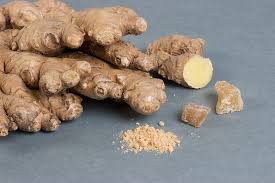
Ginger – Ginger is a plant whose roots are used for spices. Although the ginger can be used with the root to cook, it is also cut dried and blended into a powder.
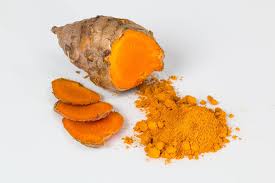
Tumeric – Tumeric comes from the same plant family as ginger and like ginger it’s roots are used for spices. The roots are dried and blended into a powder
I told her, I still don’t believe this. Prove it to me. So she gave me some examples of common Moroccan recipes. After, she explained further what she meant and then I finally understood what she meant about Moroccan core spices. Let’s go over some of the dishes that were used as examples of using the core spices. I’ll provide a description of each of the dishes as well.
Examples of dishes using Moroccan core spices
Djaj Mhamer or reddened(roasted) chicken is a traditional Moroccan dish. The dish is distinguished by its taste using key ingredients preserved lemons and green olives. This tagine can be prepared with chicken pieces or a whole chicken. Served with homemade fries and Moroccan bread.
Spices used – Salt, Black Pepper, Ginger, Tumeric, Saffron
B&M or Moroccan baked eggs is a simple, flavorful, vegetarian dish. The actual name of B&M stands for b3d & matisha, which stands for egg and tomato. This popular meal is eaten for breakfast but is so fulling, it is sometimes eaten for dinner as well.
Spices used – Salt, Black Pepper, Ginger, Tumeric, All Spice, Cinamon, Cumin
L7am b lber9ou9 – The name of this dish, when translated to English means meat with prunes. This is a tajine that produces a dish that is both salty and sweet. It must be cooked slowly in order that all the ingredients are mixed throughout the meat. This is dish is served when there are get-togethers and weddings(I remember eating this at my wedding).
Spices used – Cinnamon, Saffron, Salt, Ginger, Black Pepper, Tumeric, Sugar
Couscous – Probably the most famous Moroccan dish. This dish is made usually of meat and vegetables cooked in a delicious broth served on a bed of steamed semolina grains. The variations of Couscous are too many to describe but Couscous can be cooked with chicken, beef, or lamb. These are all traditional Moroccan dishes that are prepared in Morocco especially on Fridays.
Spices used – Salt, Black Pepper, Ginger, Tumeric, Cumin, Saffron
Are you hungry now? Don’t worry, I will be adding the recipes to these delicious dishes. Did you notice the spices used to make these dishes? All of them use the core ingredients listed above
My wife further explained to me that these core spices are used to season the meat (or eggs) being used in the dishes. The meat doesn’t matter, it could be chicken (djaj), beef (l7am), lamb (genmi) or fish (hoot), or even eggs (b3id) when cooking Moroccan dishes, these 4 core Moroccan spices will be used. Depending on the dish, additional spices will be used. Now I understood exactly what she was saying.
There are other spices commonly used in Morocco. The only difference is that they are not used in every dish. Let’s quickly go through a few of these other Moroccan spices.
Other popular Moroccan spices used
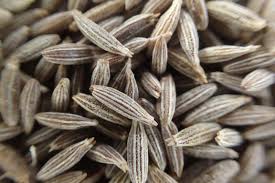
Cumin – Spice made from a plant located in the Middle East and Asia. The seeds of this plant are then dried and either used whole and blended into a powder.

Saffron – Spice from a plant mostly located in Morocco. The interesting thing about this spice is the threads from this plant can only be handpicked. Each plant only produces 3-4 threads. This is the reason why the price of Saffron is so expensive. Another note, if you put 3 threads in a cup of water and drink the water, it’s known to remove depression.
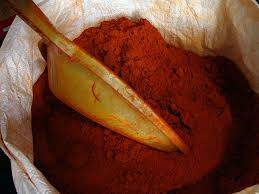
Paprika – spice made from bell pepper or sweet pepper. Paprika is created by completely drying the pepper and then blending it into a powder.
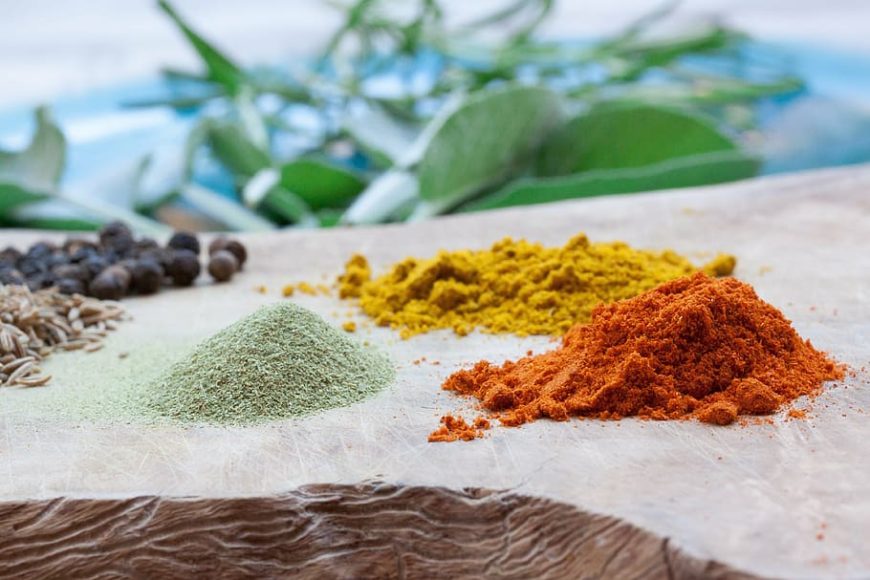
Ras lhanoot – This is a special blend of spices that the shop owners sell at their shops. The spices can vary from each store. Typically Ras lhanoot will contain Cardamom, Coriander, Black Pepper, Paprika, Fenugreek Cumin, Clove, Cinnamon, Nutmeg, Mace, Allspice, Ginger, Chili Peppers, and Turmeric.
Like I mentioned above, let’s go into some of the recipes and see step by step, how these Moroccan spices are being used to create these exquisite dishes. But before we jump into the recipes, I wanted to give a quick warning if you want to try some of these recipes.
Warning
While cooking these Moroccan dishes can be done with most kitchenware, most people prefer to use a tajine. A tajine is a cooking dish used to make a lot of Moroccan dishes, some of which will be described below. The base of the Tajine is wide and shallow and the cover is tall and cylindrical. The shape is known to return condensation to the bottom of the tajine, allowing for more flavor to be retained in the food.
While this is an excellent way to cook Moroccan dishes, most of these Tajines are made from clay and any concentrated heat on the surface of the tajine may crack the tajine. To protect the tajine, especially clay made tajines, always use a heat diffuser. The heat diffuser will be placed directly on the heat source and distribute the heat evenly on its surface. Your tajine can then be placed directly on the heat diffuser and you can feel assured that your tajine will not crack. If you’re interested in purchasing a tajine or heat diffuser you can purchase one by clicking on the pictures or clicking here or here.
Have some recipes you want to share or learn? Join the Discord server https://discord.gg/QC4w5NCtM4
Recipes
Djaj Mhamer
Ingredients
- 8-10 pieces of chicken
- 1 tablespoon smen, olive oil or butter
- half a preserved lemon
- 1 cup green olive’s
- 1 teaspoon thyme
- 1 onion diced
- 4-5 cloves of grated garlic
- 1 teaspoon ginger
- 1 cup fresh coriander chopped
- a pinch of saffron
- squeezed lemon juice from 1 lemon (for cleaning)
- squeezed lemon juice from 1 lemon (for marinade)
- 4 tablespoons olive oil
- 1 teaspoon salt
- 1 teaspoon pepper
- 1 teaspoon paprika
- 1 teaspoon turmeric
Instructions
Cleaning the chicken
- in a bowl add the chicken
- pour the salt on the chicken
- add the lemon juice into the bowl
- rub the lemon and salt on the chicken to clean the chicken.
- rinse the chicken with water and discard the lemon and salt mixture
Create a marinade
- in a bowl mix onions, garlic, cilantro, lemon juice, saffron, ginger, paprika, turmeric salt, pepper, and 4 tablespoons olive oil
- rub the chicken with the marinade, make sure to rub all the marinade on the chicken thoroughly
- cover the bowl with the marinaded chicken, and put in the fridge for about 2 hours
Bringing it together
- in a tajine or large pot heat the smen, olive oil, or butter
- add the chicken and preserve lemon
- increase the heat to medium-high and cook the chicken thoroughly.
- add the remaining contents of the marinade from the bowl
- add water to cover the chicken halfway
- once the water starts to boil reduce the heat to low and cover for 45 min, stirring occasionally
- after 45 min remove the chicken from the sauce and bake in a baking ban for 20 min at 350 ° Fahrenheit
- keep the heat at low-medium for the sauce in the tajine or large pot.
- add the olives, thyme, and additional salt and black pepper to taste
- simmer for 15 min until the sauce thickens
- in a Gs3a or large serving plate, place the chicken, then pour the sauce over the chicken
- serve with bread and french fries
B&M
Ingredients
- 1/2 cup diced yellow onion
- 1/2 cup diced red bell pepper
- 1 jalapeño, seeds removed and minced
- 2 teaspoons minced garlic
- 1 teaspoon ground cumin
- 1 teaspoon smoked paprika
- 1/4 teaspoon ground cinnamon
- 1/4 teaspoon allspice
- 2 tablespoons harissa
- 2 teaspoons olive oil
- 28 ounce can crushed tomatoes
- 15 ounce can chickpeas, rinsed and drained
- 1 teaspoon lemon zest
- 2 tablespoons chopped cilantro
- 5 eggs
Instructions
- preheat oven to 375 ° Fahrenheit
- add olive oil in pan and heat stove to medium heat
- add in the onion, red bell pepper, and jalapeño and sauté until for about 2 min
- add in the garlic, spices, and salt and sauté for another min
- stir in the harissa, crushed tomatoes, lemon zest until everything is mixed evenly.
- turn the heat down to low and simmer for 7 minutes or until the sauce has thickened slightly
- stir in the cilantro
- crack the eggs into the pan over the sauce and season with salt and black pepper
- place the entire pan in the oven and bake until the eggs are just set, 10 min (make sure pan is oven-ready)
- sprinkle with cilantro and serve with Moroccan bread.
L7am b lber9ou9
Ingredients
- 1 lbs Beef cut into medium-sized cubes
- 1 onion
- 3 tablespoons vegetable or canola oil
- 6 grated garlic cloves
- 1 cup of water
- 1 teaspoon salt
- 1 teaspoon ground ginger
- 1 teaspoon black pepper
- 1 teaspoon turmeric
- 1/2 teaspoon cinnamon (for the meat)
- 1 tablespoon cinnamon (for the plums)
- a pinch of sesame seeds
- 1 tablespoon sugar
- a pinch of saffron
- 1 cup plums
Instructions
- preheat tajine or pot and add oil
- add the beef
- add the grated garlic, salt, turmeric, black pepper cinnamon, ginger, and saffron to season the beef and cook on medium-high for about 7 min stirring occasionally
- add the diced onions and mix in with the beef
- reduce heat to low, cover and simmer for about 15 min
- add a bit of water until the meat is barely half cover, mix everything
- increase the heat to medium, cover, and cook for about 15 min (your cooking until the meat is tender, you might need to increase the time depending on your stove)
- in another pot add the rest of the water and increase the heat to medium to heat the water
- add the plums to the hot water
- add the sugar and cinnamon to the pot and stir in with the plums
- continue to cook the plums for about 10 min
- pour the contents of the pot with the plums on to the tajine or pot with the beef (the beef should be tender before adding the plums)
- sprinkle the sesame seeds over plums and beef
- Serve with Moroccan bread
Couscous
Before you begin, you’re going to need a couscous steamer. This is basically a large pot, with an additional steamer component that is put at the top with cover. The meat will be cooked in the lower component and the Couscous will be cooked in the upper component. If you’re interested in purchasing a couscous steamer click on the image or click here.
Ingredients
- 1 pound couscous
- 1 pound beef
- 3 Carrots cut lengthwise
- 3 Zucchini cut lengthwise
- 3 small tomatoes diced
- a piece of squash cut into large pieces
- 1 onion diced
- 2 cups parsley
- 2 cups coriander
- 1 can chickpeas
- 2 tablespoons olive oil
- 1/2 teaspoon salt
- 1/2 teaspoon black pepper
- 1/2 teaspoon ground ginger
- 1/2 teaspoon Cumin
- a pinch of saffron
- 1 teaspoon smen (optional)
- water
Instructions
Preparing the sauce and meat
- using the pot portion of the couscous steamer (lower component), add the oil and set the heat at medium
- add the onions and saute for about 2 min
- add the beef and cook for around 15 min
- add the diced tomatoes, parsley, coriander and spices
- mix these things together and cook for 10 min
- add water to cover beef, cover, and leave it cooking for 1 hour
Preparing the couscous
- pour the couscous into a large serving plate
- add a little water at a time to the couscous and try to thicken the couscous
- pour some more water on to the couscous and leave it (the couscous will soak up the water)
- after 1 hour of cooking the meat, add the couscous to the top component of the couscous steamer and place this component above the top of the pot with the meat
- cover the top portion and let it cook for 20 min
Bringing it together
- in a Gs3a or large serving plate, place the couscous and let it cool
- once it cools add some more water and thicken it with your hands
- add salt and some argan oil and mix it with your hands
- place the couscous in the top component again
- add the carrots to the pot with the meat
- 10 min after adding the carrots, add the chickpeas, zucchini, and squash
- place the top component with the couscous back on top of the pot.
- cover and cook another 10 min
- in the Gs3a or large serving plate, place the couscous as a base
- add the meat placing it equally around the Gs3a
- add the rest of the ingredients, placing the squash, zucchini, and carrots evenly around the Gs3a
- eat with a fork or your hands
How to buy Moroccan spices

If you’re not living in Morocco or any Arab country, you can buy these spices in your regular supermarket. Some spices may not be available depending on where you live. If this is the scenario for you, then you will have to a shop that specializes in spices or an ethnic type of grocery store.
This is all fine and good but honestly, it is kind of boring. Picking up spices, paying for them and leaving with barely talking to anyone is not really adventurous and using new skills. Here is a scenario, that may take you out of your comfort zone but it is an experience that you should try at least once in your life.
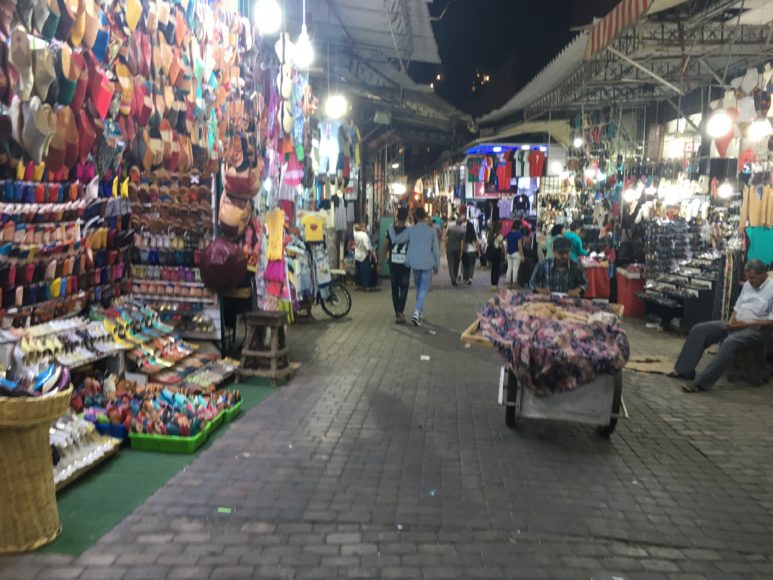
If you are in Morocco, you can buy the Moroccan spices at the souq. The souq is a marketplace where you can buy a variety of things from groceries to household items. In almost every city and town in Morocco, you will find a souq. You will notice the souq as soon as you see a lot of people and see shops after shops. The shops with the Moroccan spices will be easily found as the best spices in the shop will be displayed in front of the store.
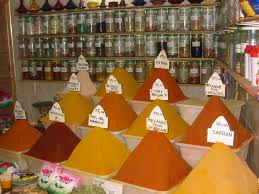
When speaking to the shop owner or the worker at the shop they may not speak English. This is where the fun begins. Don’t worry, I’m going to go through a typical conversation that you can have. Using the example below as a template, you should be able to buy any spice at any spice shop without any problems.
Let’s say that you want to cook Couscous to impress your Moroccan friends but you don’t have cumin and saffron. So you decide to go to the souq to pick up the spices you don’t have. Here is how the conversation might go.
| Darija (Moroccan Arabic) | English | Notes |
|---|---|---|
| You: Salam, kayn kamun? | You: Hello, Do you have cumin? | The proper term should be wash kayn kamun (wash = do) but because of the speed of the conversation, the word wash is omitted and just understood. |
| Shop owner: iyeh, sh7al bghiti? | Shop owner: Yes, how much do you want? | |
| You: Jouj draham 3afak | You: 2 dirhams worth please. | Notice that you’re asking for 2 dirhams. When buying small amounts of spices you ask based on price rather than weight. Asking for weight is done when asking for large amounts of spices like 1/4 kilo or more. |
| Shop owner: hak, shnoo akhar? | Shop owner: here it is, what else would you like? | If translating directly it sounds kind of rude (take this, what else?) but because of the speed of the conversation words are omitted and the conversation is assumed to be friendly. |
| You: kayn z3fran? | You: Do you have saffron? | |
| Shop owner: iyeh, sh7al n3ber lik? | Shop owner: Yes, how much should would you like. | The direct translation is yes, how much should I weigh for you but this is understood is how much do you want. |
| You: bghit 3ashra dirham 3afak | You: I would like 10 dirhams worth please. | |
| Shop owner: hak, bghiti shi haja ukra? | Shop owner: Here you go, do you want anything else? | |
| You: Safi, shukran | You: That’s all, thanks. |
Using this conversation template above just replace the spice with the spice that you want to buy. The conversation may vary from the store owner to store owner but if you ever get lost in the conversation just go back to asking the question kayn kamun (or whatever spice you want to buy). Eventually, the shop owner is going to want to know how much of the spice you want and that’s when you tell them the monetary(dirham) amount.
Useful Moroccan spices terms
Here is a list of the name of Moroccan spices in Darija (Moroccan Arabic). You can use any of the words listed here in the conversation template above to buy those specific Moroccan spices.
| Darija (Moroccan Arabic) | English |
|---|---|
| 3triyat | Spices |
| ml7a | Salt |
| bzar | Black Pepper |
| kamun | Cumin |
| khar9um | Tumeric |
| z3fran | Saffron |
| guza | Nutmeg |
| 9arfa | Cinnamon |
| ta7mira | Paprika |
| sknjber | Ginger |
| sudaniya | Chilli |
| z3tar | Oregano |
| nuwiwira | All Spice |
| z3ter | Thyme |
